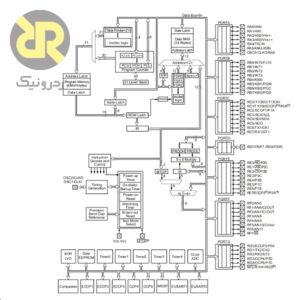



میکروکنترلر LPC2388FBD144
| PartNumber | LPC2388FBD144 |
6,667,200 ﷼
میکروکنترلر LPC2388FBD144 پردازنده 32 بیتی ARM7TDMI-S با فرکانس 72MHZ ، حافظه فلش 512 کیلو بایت و98 کیلو بایت حافظه SRAM
ناموجود
این محصول در حال حاضر موجود نمیباشد اگر به این محصول نیاز دارید اطلاعات زیر را تکمیل کنید
“
میکروکنترلر LPC2388FBD144
میکروکنترلر LPC2388FBD144 میکروکنترلر 32 بیتی پیشرفته از شرکت NXP مبتنی بر ARM7TDMI-S دارای ویژگی های 512KB کیلوبایت حافظه فلش ، 64 KB کیلوبایت حافظه SRAM ، و 104 عدد GPIO ، با 5 تایمر کانتر چند منظوره با قابلیت حالت مقایسه و pwm ، یک DMA controller، قابلیت full-speed USB 2.0 device/host/OTG ، مبدل آنالوگ به دیجیتال 10 بیتی ،مبدل دیجیتال به آنالوگ 10 بیتی ، یک رابط SPI ، سه رابط I²C-bus ، رابط I²S-bus ،چهار رابط UARTs، یک پروتکل ارتباطی CAN با دو کانال ، رابط SD/MMC ، رابط Ethernet MAC with MII/RMII interface می باشد. این پردازنده می تواند با تغذیه 3-3.6 ولت تا فرکانس 72MHz بدون اختلال در عملکرد ، دستورات را اجرا کند.
کاربردها
-
- پروژه های عمومی الکترونیک
- اتوماسیون
- اینترنت اشیاء
- کنترل
- درایو انواع موتور ها
- سیستم های ابزار دقیق
- رباتیک
ویژگیهای محصول
با توجه به اهمیت مطالب فنی از ترجمه صرف نظر شده است.
| Features:
· ARM7TDMI-S processor, running at up to 72 MHz. · Up to 512 kB on-chip flash program memory with In-System Programming (ISP) and In-Application Programming (IAP) capabilities. Flash program memory is on the ARM local bus for high performance CPU access. · 64 kB of SRAM on the ARM local bus for high performance CPU access. · 16 kB SRAM for Ethernet interface. Can also be used as general purpose SRAM. · 16 kB SRAM for general purpose DMA use also accessible by the USB. · Dual Advanced High-performance Bus (AHB) system that provides for simultaneous Ethernet DMA, USB DMA, and program execution from on-chip flash with no contention between those functions. A bus bridge allows the Ethernet DMA to access the other AHB subsystem. · EMC provides support for static devices such as flash and SRAM as well as off-chip memory mapped peripherals. · Advanced Vectored Interrupt Controller (VIC), supporting up to 32 vectored interrupts. · General Purpose AHB DMA controller (GPDMA) that can be used with the SSP serial interfaces, the I2S-bus port, and the Secure Digital/MultiMediaCard (SD/MMC) card port, as well as for memory-to-memory transfers. · Serial Interfaces: § Ethernet MAC with associated DMA controller. These functions reside on an independent AHB. § USB 2.0 device/host/OTG with on-chip PHY and associated DMA controller. § Four UARTs with fractional baud rate generation, one with modem control I/O, one with IrDA support, all with FIFO. § CAN controller with two channels. § SPI controller. § Two SSP controllers, with FIFO and multi-protocol capabilities. One is an alternate for the SPI port, sharing its interrupt and pins. These can be used with the GPDMA controller. § Three I2C-bus interfaces (one with open-drain and two with standard port pins). § I2S (Inter-IC Sound) interface for digital audio input or output. It can be used with the GPDMA.
|
· Other peripherals:
§ SD/MMC memory card interface. § 104 General purpose I/O pins with configurable pull-up/down resistors. § 10-bit ADC with input multiplexing among 8 pins. § 10-bit DAC. § Four general purpose timers/counters with 8 capture inputs and 10 compare outputs. Each timer block has an external count input. § One PWM/timer block with support for three-phase motor control. The PWM has two external count inputs. § Real-Time Clock (RTC) with separate power pin, clock source can be the RTC oscillator or the APB clock. § 2 kB SRAM powered from the RTC power pin, allowing data to be stored when the rest of the chip is powered off. § WatchDog Timer (WDT). The WDT can be clocked from the internal RC oscillator, the RTC oscillator, or the APB clock. · Standard ARM test/debug interface for compatibility with existing tools. · Emulation trace module supports real-time trace. · Single 3.3 V power supply (3.0 V to 3.6 V). · Three reduced power modes: idle, sleep, and power-down. · Four external interrupt inputs configurable as edge/level sensitive. All pins on PORT0 and PORT2 can be used as edge sensitive interrupt sources. · Processor wake-up from Power-down mode via any interrupt able to operate during Power-down mode (includes external interrupts, RTC interrupt, USB activity, Ethernet wake-up interrupt). · Two independent power domains allow fine tuning of power consumption based on needed features. · Each peripheral has its own clock divider for further power saving. · Brownout detect with separate thresholds for interrupt and forced reset. · On-chip power-on reset. · On-chip crystal oscillator with an operating range of 1 MHz to 25 MHz. · 4 MHz internal RC oscillator trimmed to 1 % accuracy that can optionally be used as the system clock. When used as the CPU clock, does not allow CAN and USB to run. · On-chip PLL allows CPU operation up to the maximum CPU rate without the need for a high frequency crystal. May be run from the main oscillator, the internal RC oscillator, or the RTC oscillator. · Boundary scan for simplified board testing. · Versatile pin function selections allow more possibilities for using on-chip peripheral functions. |


















behnam –
میکروکنترلر LPC2388FBD144
پر کاربرد در رباتیک و درایو انواع موتور هامی باشد